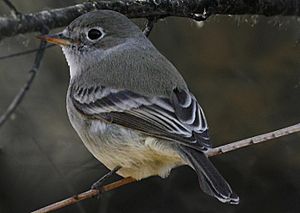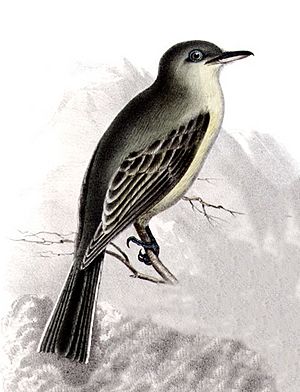American gray flycatcher facts for kids
Quick facts for kids American gray flycatcher |
|
|---|---|
 |
|
| Conservation status | |
| Scientific classification | |
| Genus: |
Empidonax
|
| Species: |
wrightii
|
The American gray flycatcher (Empidonax wrightii) is a small bird found in North America. It's part of the tyrant flycatcher family and loves to eat insects. You can often find it in dry areas of western North America, especially in places like the Great Basin. It lives in different habitats, from sagebrush plains to pinyon pine and juniper woodlands, and even ponderosa pine forests. This bird looks for insects from shrubs or low tree branches.
The American gray flycatcher belongs to a group of birds called Empidonax flycatchers. These birds look very similar, which makes them hard to tell apart. To identify them, scientists often listen to their songs, look at where they build their nests, and check their habitat. However, the American gray flycatcher has a special trick: it wags its tail downwards. Other Empidonax flycatchers usually flick their tails upwards!
Contents
About the American Gray Flycatcher
American gray flycatchers are small birds, but they are a bit larger than most other Empidonax flycatchers. An adult bird is usually about 15 cm (5.9 in) long. Its wingspan is around 22 cm (8.7 in), and it weighs about 12.5 g (0.44 oz).
Adult flycatchers have light gray feathers on their backs. Their wings and tail are a bit darker. After they molt their feathers in the fall, they might have a slight olive green tint. Their undersides are whitish, sometimes with a little yellow when their feathers are new. They have white bars on their wings and a faint white ring around their eyes. They also have a light band above their bill. Compared to other similar flycatchers, the American gray flycatcher has a long, thin bill and a long tail. The bottom part of its bill is often paler.
Young flycatchers, called juveniles, look a lot like the adults. But they have more olive and yellow colors. Their wing bars are also more buffy (a yellowish-brown color), and their chests are brownish.
Only the male American gray flycatcher sings. Its song is a strong, two-part sound like chuwip or wilip. Sometimes, a softer, higher-pitched teeap or seep sound is added. Both male and female birds make a dry pit or wit call. Females often call out when they are looking for food or gathering materials for their nest.
Where They Live and Travel
The American gray flycatcher breeds in western North America. This includes areas from southern British Columbia down through Washington, Oregon, and California. Their breeding range also stretches east across Nevada, southern Idaho, Utah, northern Arizona, southwestern Wyoming, western Colorado, and northwestern New Mexico.
These birds arrive at their breeding grounds between mid-April and mid-May, depending on the area. They leave for warmer places between mid-August and mid-September. Their migration journey takes about seven weeks in both spring and fall. Male flycatchers usually arrive at the breeding grounds about a week before the females.
During winter, the American gray flycatcher travels south. They spend the colder months in Baja California Sur, southeastern Arizona, and central Sonora down to central Oaxaca in Mexico. A few might also spend winter in western Texas and southern California.
Their Home and Food
Habitat
The American gray flycatcher likes to live in shrublands, open woodlands, or forests. These places usually have not many plants growing on the ground. They often live among sagebrush plants. Other common plants in their homes include bitterbrush, rabbitbrush, mountain-mahogany, juniper trees, pinyon pines, and ponderosa pines.
When they are migrating, they often use similar habitats. But they might also be found near rivers in areas with willows, oaks, or mesquite trees. In winter, they prefer dry, open areas with shrubs and scattered trees.
Diet
The American gray flycatcher mainly eats insects and other small creatures without backbones. It's possible they eat fruit in winter, but this hasn't been fully confirmed.
Most of their food is caught while they are flying or picked up from the ground. A flycatcher will wait on an open branch, usually on a shrub or low tree. When an insect flies by, the bird will quickly fly out to catch it. Sometimes, they will hover in the air and pick insects off leaves or tree bark.
Family Life
Reproduction
During the breeding season, American gray flycatchers are very protective of their territory. Males will set up a territory and attract a female using their songs and displays. They seem to stay with one partner, but sometimes they might mate with other birds.
The nest of an American gray flycatcher is quite big and not as tightly built as nests of other Empidonax flycatchers. The female bird builds the nest, usually by herself. She uses different plant materials, like grass stalks and strips of bark. The inside of the nest is often lined with soft materials such as wool, hair, feathers, or soft grasses. Nests can be found in sagebrush, bitterbrush, junipers, or pines. The height of the nest depends on the plant it's in, but it's usually between 1–6 m (3.3–19.7 ft) above the ground. Most nests are placed where a branch meets the tree trunk, but some are on larger branches further away.
The female lays one egg each day, usually a total of three or four eggs. She then incubates the eggs for about two weeks. Even though the eggs are laid on different days, they usually all hatch on the same day. The baby birds, called chicks, are born without much downy fluff. Both parents work together to feed the nestlings. The young birds are ready to leave the nest, or fledge, about 16 days after they hatch.
See also
 In Spanish: Mosquero gris para niños
In Spanish: Mosquero gris para niños



